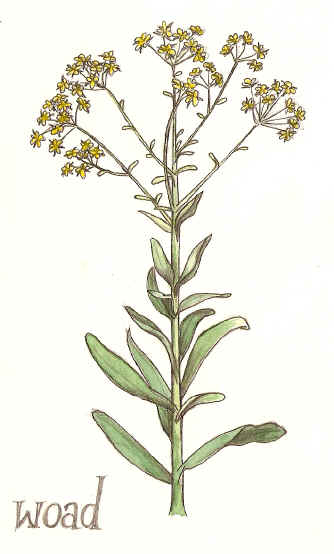I've seen a lot of posts recently relating to woad, so I've decided to do a little miniseries. In addition, Etaine na Preachain and I will be doing a class on modern applications for woad at Preachain's Pennsic Early Period A&S Day on August 10, 2016.
So.... many of the posts I've seen recently related to folks trying to find "alternatives" such as modern make up or modern body paint. Why find an alternative when you can use the real thing? First and foremost, I'd like to say that processed woad that can be used for body paint is pretty readily available at Pennsic. If you don't go, it's easy to ask a friend to pick you up a few balls of woad from the Liminers Guild for $4 each. I'm still looking for an online source and will add it here when I find it.
What is woad?
Woad is made from the woad plant (Isatis tinctoria). Woad is one of the original sources of blue dyes. The plant is native to Europe and has been gathered and/or cultivated by humans since the stone age.
How is the pigment in woad derived from the plant?
The leaves are chopped up into a fine paste, formed into balls, and left to dry for about four weeks. Then, it was sprinkled with water and allowed to ferment. The resulting balls are then powdered, and for use as body paint, mixed with water or whisky.
Historical Evidence for Woad as body paint
According to historical accounts, the Britons "dye their bodies with woad, which produces a blue colour" (Caesar, Gallic War, V.14; also Pomponius Mela, III.6.51). In ancient times, it seems to have been used as a ceremonial accompaniment to battle, whether to intimidate foes or paint symbols of protection.
Some scholars also speculate that the plant was believed to have magical properties, based on its medicinal applications- the ability to staunch bleeding and anti-bacterial properties (Carr, 2005). Such properties would have been ideal for a body paint worn into battle!
Modern Uses
In modern reenactment, it is used before battle to beautify and to unify, and to allow the artists to put love in the form of art on to each warrior before a battle. It is used before we have ceremonies, to signify the importance of an occasion and connect us with our ancestors. The act of applying woad is an act of art in and of itself, in which the artist strives to use the natural features of the body to enhance the woad.
Many fiber artisans who spin, dye and weave their own fabrics still use woad as a dye to achieve shades of blue and/or indigo.
Next up in the series: Processing Woad to Create Body Paint
~Ceanag

